Resource and Talent Planning Report: Labour Market and Skills Analysis
VerifiedAdded on 2022/11/28
|12
|3616
|304
Report
AI Summary
This report delves into the critical aspects of resource and talent planning, essential for effective human resource management within organizations. It begins by exploring the influence of labour market trends, such as the 'boomerang labour' phenomenon and the rise of younger, tech-savvy employees, on workforce planning. The report then examines the legal requirements impacting workforce planning, including federal, state, and international laws, emphasizing the importance of compliance. It identifies current and anticipated skills crucial for success in the modern business environment, such as blockchain, sales, business analysis, people management, and adaptability. Furthermore, the report outlines the significance of well-defined job descriptions and specifications in attracting top talent, along with the different types of recruitment and selection methods. The context of Mark and Spencer is used throughout the report to illustrate key concepts and provide real-world examples. Finally, the report concludes by summarizing the key findings and emphasizing the importance of strategic resource and talent planning for organizational success.
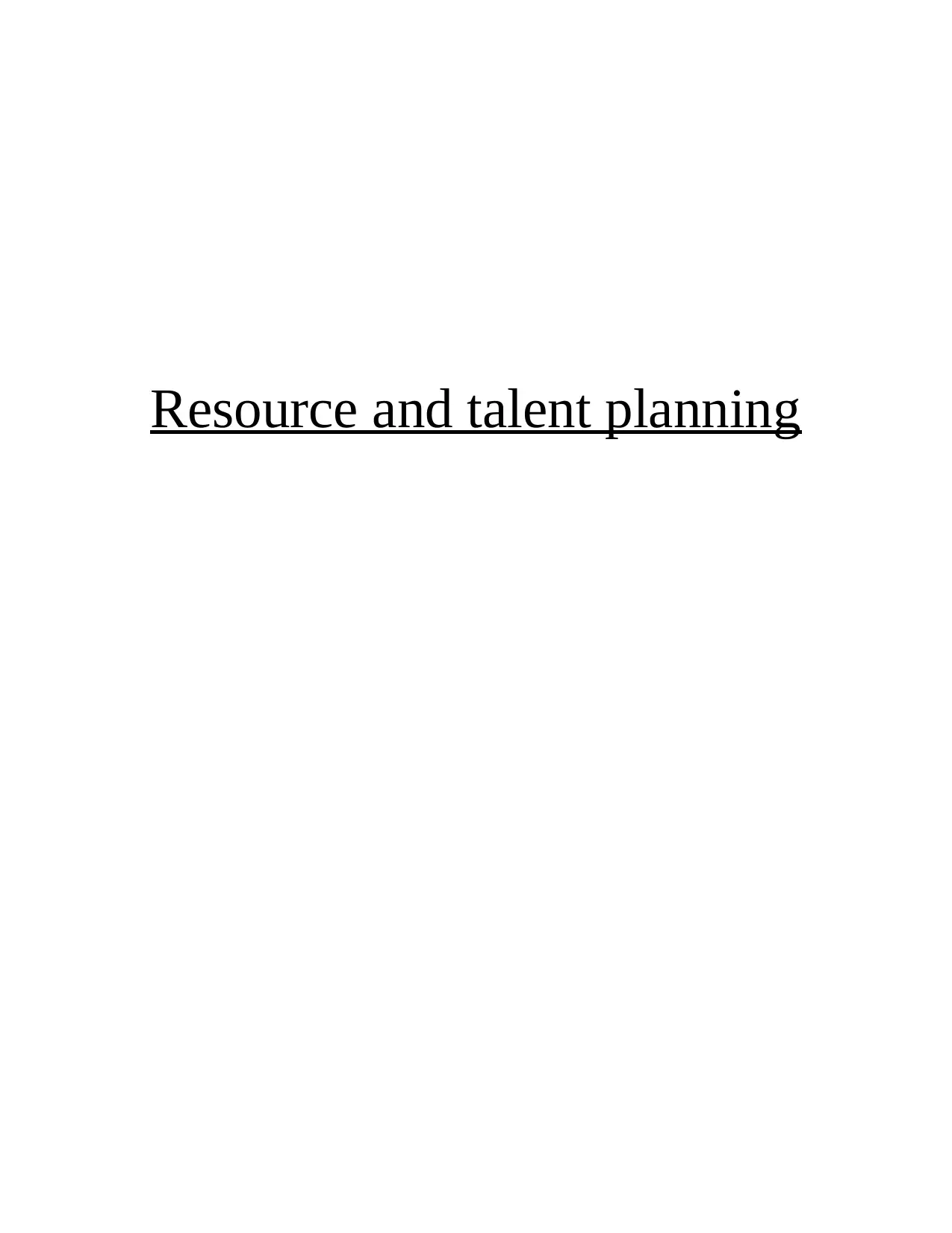
Resource and talent planning
Paraphrase This Document
Need a fresh take? Get an instant paraphrase of this document with our AI Paraphraser
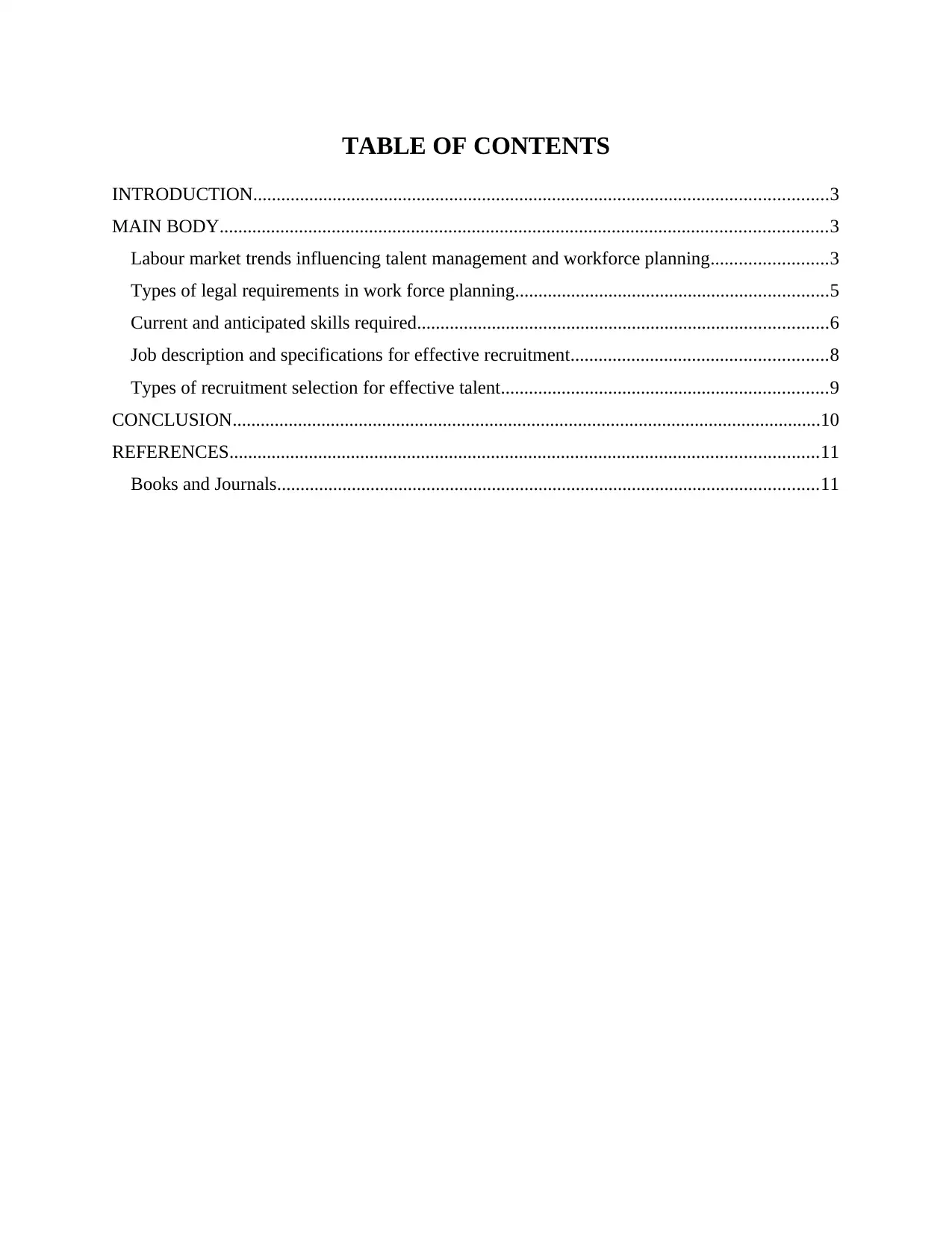
TABLE OF CONTENTS
INTRODUCTION...........................................................................................................................3
MAIN BODY..................................................................................................................................3
Labour market trends influencing talent management and workforce planning.........................3
Types of legal requirements in work force planning...................................................................5
Current and anticipated skills required........................................................................................6
Job description and specifications for effective recruitment.......................................................8
Types of recruitment selection for effective talent......................................................................9
CONCLUSION..............................................................................................................................10
REFERENCES..............................................................................................................................11
Books and Journals....................................................................................................................11
INTRODUCTION...........................................................................................................................3
MAIN BODY..................................................................................................................................3
Labour market trends influencing talent management and workforce planning.........................3
Types of legal requirements in work force planning...................................................................5
Current and anticipated skills required........................................................................................6
Job description and specifications for effective recruitment.......................................................8
Types of recruitment selection for effective talent......................................................................9
CONCLUSION..............................................................................................................................10
REFERENCES..............................................................................................................................11
Books and Journals....................................................................................................................11
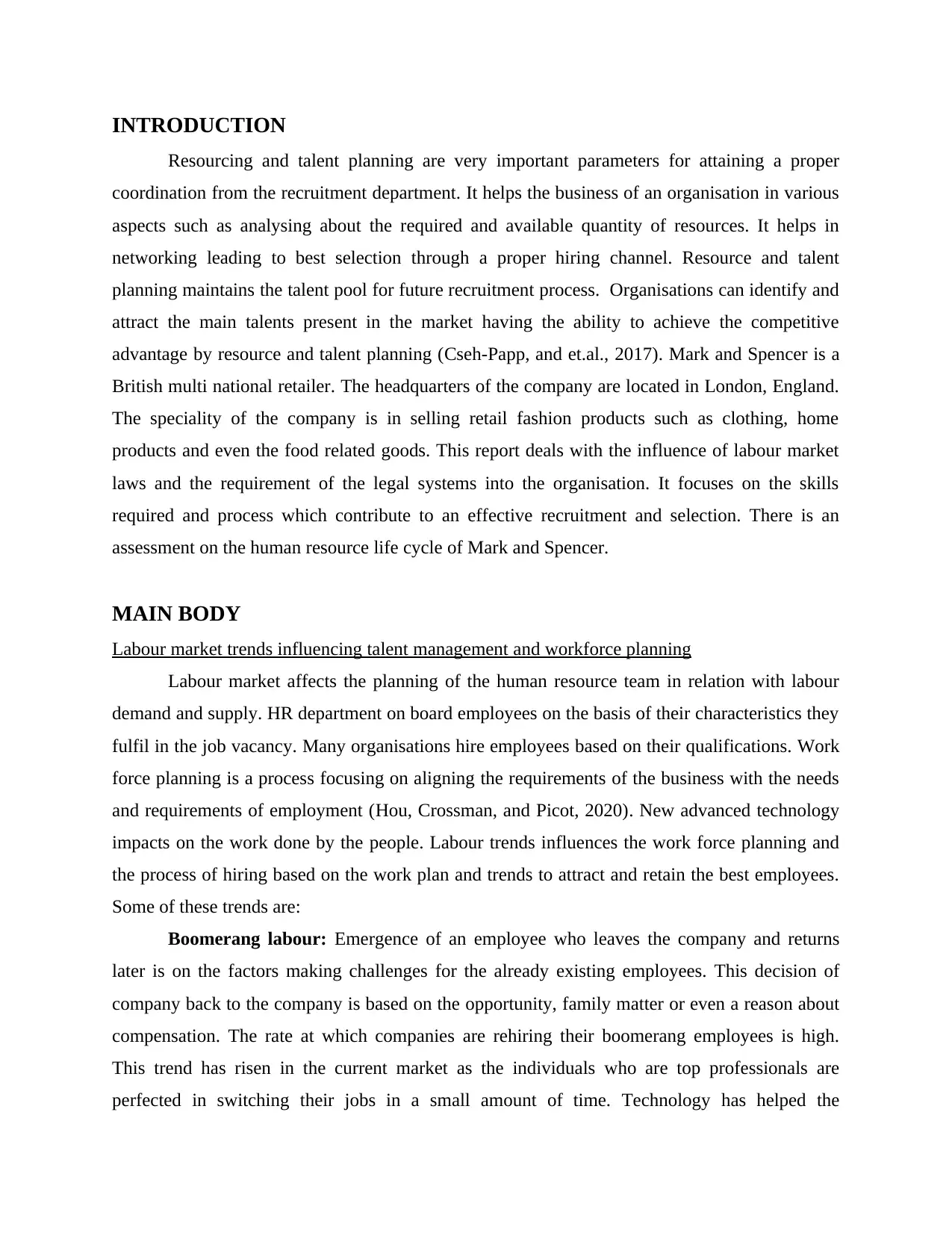
INTRODUCTION
Resourcing and talent planning are very important parameters for attaining a proper
coordination from the recruitment department. It helps the business of an organisation in various
aspects such as analysing about the required and available quantity of resources. It helps in
networking leading to best selection through a proper hiring channel. Resource and talent
planning maintains the talent pool for future recruitment process. Organisations can identify and
attract the main talents present in the market having the ability to achieve the competitive
advantage by resource and talent planning (Cseh-Papp, and et.al., 2017). Mark and Spencer is a
British multi national retailer. The headquarters of the company are located in London, England.
The speciality of the company is in selling retail fashion products such as clothing, home
products and even the food related goods. This report deals with the influence of labour market
laws and the requirement of the legal systems into the organisation. It focuses on the skills
required and process which contribute to an effective recruitment and selection. There is an
assessment on the human resource life cycle of Mark and Spencer.
MAIN BODY
Labour market trends influencing talent management and workforce planning
Labour market affects the planning of the human resource team in relation with labour
demand and supply. HR department on board employees on the basis of their characteristics they
fulfil in the job vacancy. Many organisations hire employees based on their qualifications. Work
force planning is a process focusing on aligning the requirements of the business with the needs
and requirements of employment (Hou, Crossman, and Picot, 2020). New advanced technology
impacts on the work done by the people. Labour trends influences the work force planning and
the process of hiring based on the work plan and trends to attract and retain the best employees.
Some of these trends are:
Boomerang labour: Emergence of an employee who leaves the company and returns
later is on the factors making challenges for the already existing employees. This decision of
company back to the company is based on the opportunity, family matter or even a reason about
compensation. The rate at which companies are rehiring their boomerang employees is high.
This trend has risen in the current market as the individuals who are top professionals are
perfected in switching their jobs in a small amount of time. Technology has helped the
Resourcing and talent planning are very important parameters for attaining a proper
coordination from the recruitment department. It helps the business of an organisation in various
aspects such as analysing about the required and available quantity of resources. It helps in
networking leading to best selection through a proper hiring channel. Resource and talent
planning maintains the talent pool for future recruitment process. Organisations can identify and
attract the main talents present in the market having the ability to achieve the competitive
advantage by resource and talent planning (Cseh-Papp, and et.al., 2017). Mark and Spencer is a
British multi national retailer. The headquarters of the company are located in London, England.
The speciality of the company is in selling retail fashion products such as clothing, home
products and even the food related goods. This report deals with the influence of labour market
laws and the requirement of the legal systems into the organisation. It focuses on the skills
required and process which contribute to an effective recruitment and selection. There is an
assessment on the human resource life cycle of Mark and Spencer.
MAIN BODY
Labour market trends influencing talent management and workforce planning
Labour market affects the planning of the human resource team in relation with labour
demand and supply. HR department on board employees on the basis of their characteristics they
fulfil in the job vacancy. Many organisations hire employees based on their qualifications. Work
force planning is a process focusing on aligning the requirements of the business with the needs
and requirements of employment (Hou, Crossman, and Picot, 2020). New advanced technology
impacts on the work done by the people. Labour trends influences the work force planning and
the process of hiring based on the work plan and trends to attract and retain the best employees.
Some of these trends are:
Boomerang labour: Emergence of an employee who leaves the company and returns
later is on the factors making challenges for the already existing employees. This decision of
company back to the company is based on the opportunity, family matter or even a reason about
compensation. The rate at which companies are rehiring their boomerang employees is high.
This trend has risen in the current market as the individuals who are top professionals are
perfected in switching their jobs in a small amount of time. Technology has helped the
⊘ This is a preview!⊘
Do you want full access?
Subscribe today to unlock all pages.

Trusted by 1+ million students worldwide
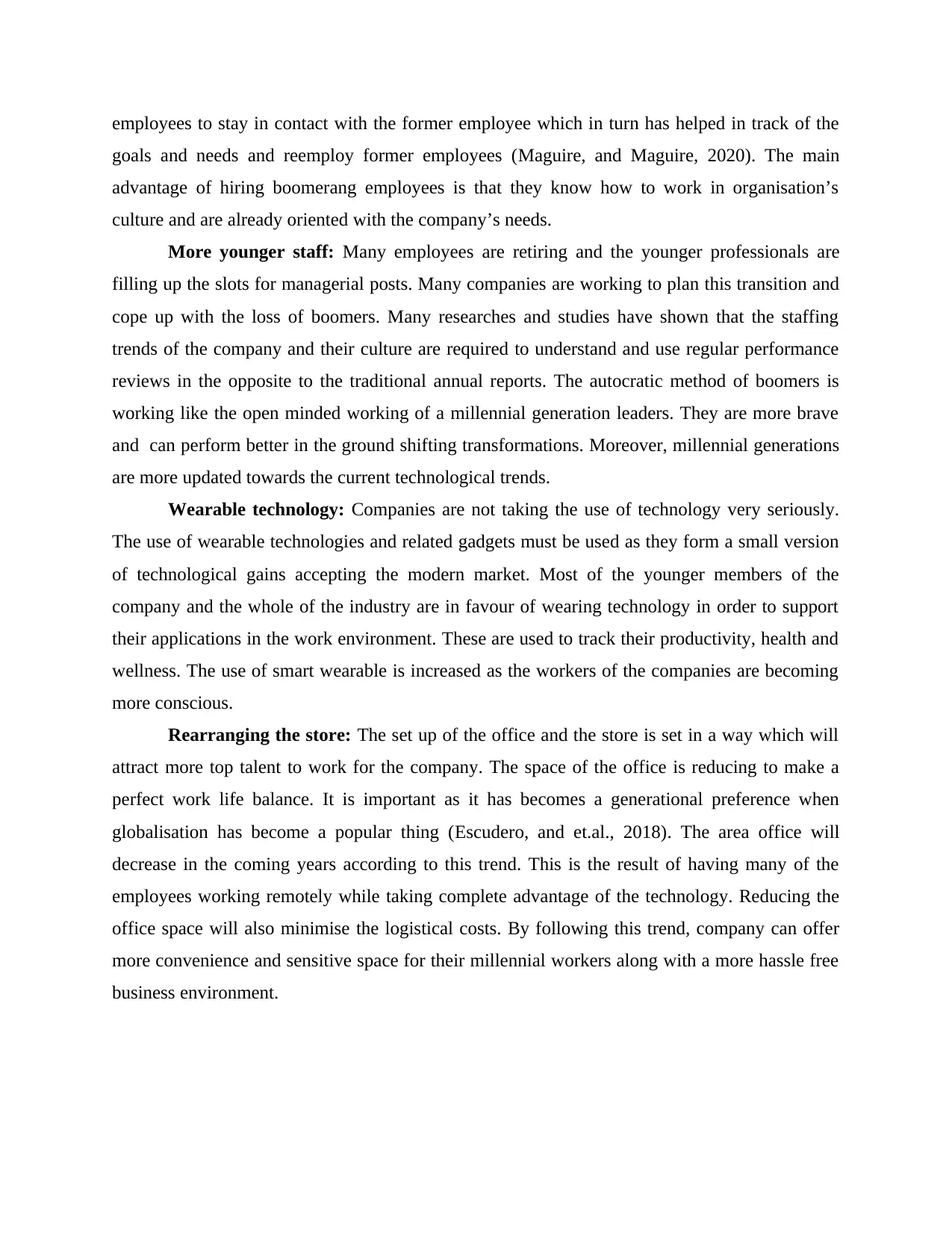
employees to stay in contact with the former employee which in turn has helped in track of the
goals and needs and reemploy former employees (Maguire, and Maguire, 2020). The main
advantage of hiring boomerang employees is that they know how to work in organisation’s
culture and are already oriented with the company’s needs.
More younger staff: Many employees are retiring and the younger professionals are
filling up the slots for managerial posts. Many companies are working to plan this transition and
cope up with the loss of boomers. Many researches and studies have shown that the staffing
trends of the company and their culture are required to understand and use regular performance
reviews in the opposite to the traditional annual reports. The autocratic method of boomers is
working like the open minded working of a millennial generation leaders. They are more brave
and can perform better in the ground shifting transformations. Moreover, millennial generations
are more updated towards the current technological trends.
Wearable technology: Companies are not taking the use of technology very seriously.
The use of wearable technologies and related gadgets must be used as they form a small version
of technological gains accepting the modern market. Most of the younger members of the
company and the whole of the industry are in favour of wearing technology in order to support
their applications in the work environment. These are used to track their productivity, health and
wellness. The use of smart wearable is increased as the workers of the companies are becoming
more conscious.
Rearranging the store: The set up of the office and the store is set in a way which will
attract more top talent to work for the company. The space of the office is reducing to make a
perfect work life balance. It is important as it has becomes a generational preference when
globalisation has become a popular thing (Escudero, and et.al., 2018). The area office will
decrease in the coming years according to this trend. This is the result of having many of the
employees working remotely while taking complete advantage of the technology. Reducing the
office space will also minimise the logistical costs. By following this trend, company can offer
more convenience and sensitive space for their millennial workers along with a more hassle free
business environment.
goals and needs and reemploy former employees (Maguire, and Maguire, 2020). The main
advantage of hiring boomerang employees is that they know how to work in organisation’s
culture and are already oriented with the company’s needs.
More younger staff: Many employees are retiring and the younger professionals are
filling up the slots for managerial posts. Many companies are working to plan this transition and
cope up with the loss of boomers. Many researches and studies have shown that the staffing
trends of the company and their culture are required to understand and use regular performance
reviews in the opposite to the traditional annual reports. The autocratic method of boomers is
working like the open minded working of a millennial generation leaders. They are more brave
and can perform better in the ground shifting transformations. Moreover, millennial generations
are more updated towards the current technological trends.
Wearable technology: Companies are not taking the use of technology very seriously.
The use of wearable technologies and related gadgets must be used as they form a small version
of technological gains accepting the modern market. Most of the younger members of the
company and the whole of the industry are in favour of wearing technology in order to support
their applications in the work environment. These are used to track their productivity, health and
wellness. The use of smart wearable is increased as the workers of the companies are becoming
more conscious.
Rearranging the store: The set up of the office and the store is set in a way which will
attract more top talent to work for the company. The space of the office is reducing to make a
perfect work life balance. It is important as it has becomes a generational preference when
globalisation has become a popular thing (Escudero, and et.al., 2018). The area office will
decrease in the coming years according to this trend. This is the result of having many of the
employees working remotely while taking complete advantage of the technology. Reducing the
office space will also minimise the logistical costs. By following this trend, company can offer
more convenience and sensitive space for their millennial workers along with a more hassle free
business environment.
Paraphrase This Document
Need a fresh take? Get an instant paraphrase of this document with our AI Paraphraser
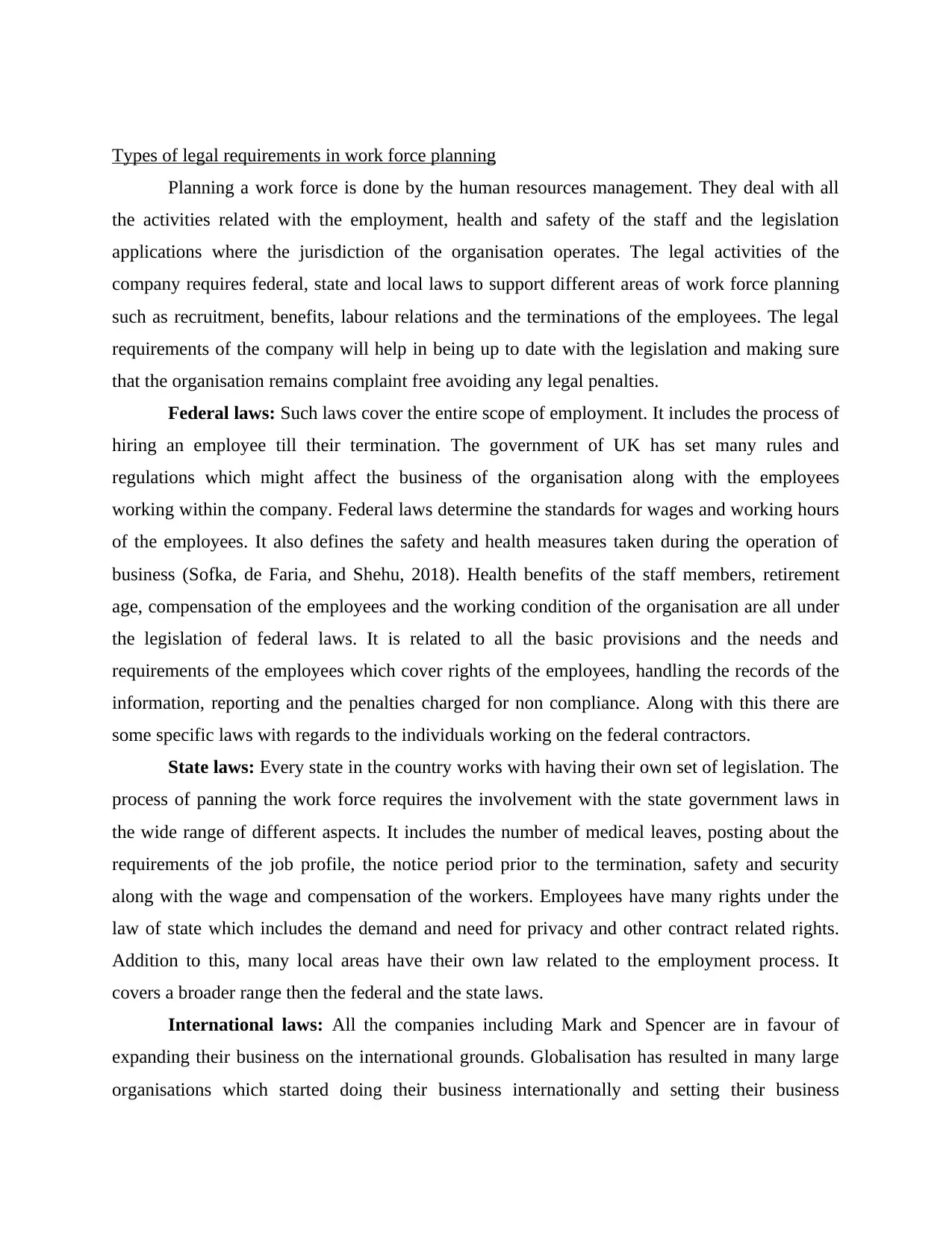
Types of legal requirements in work force planning
Planning a work force is done by the human resources management. They deal with all
the activities related with the employment, health and safety of the staff and the legislation
applications where the jurisdiction of the organisation operates. The legal activities of the
company requires federal, state and local laws to support different areas of work force planning
such as recruitment, benefits, labour relations and the terminations of the employees. The legal
requirements of the company will help in being up to date with the legislation and making sure
that the organisation remains complaint free avoiding any legal penalties.
Federal laws: Such laws cover the entire scope of employment. It includes the process of
hiring an employee till their termination. The government of UK has set many rules and
regulations which might affect the business of the organisation along with the employees
working within the company. Federal laws determine the standards for wages and working hours
of the employees. It also defines the safety and health measures taken during the operation of
business (Sofka, de Faria, and Shehu, 2018). Health benefits of the staff members, retirement
age, compensation of the employees and the working condition of the organisation are all under
the legislation of federal laws. It is related to all the basic provisions and the needs and
requirements of the employees which cover rights of the employees, handling the records of the
information, reporting and the penalties charged for non compliance. Along with this there are
some specific laws with regards to the individuals working on the federal contractors.
State laws: Every state in the country works with having their own set of legislation. The
process of panning the work force requires the involvement with the state government laws in
the wide range of different aspects. It includes the number of medical leaves, posting about the
requirements of the job profile, the notice period prior to the termination, safety and security
along with the wage and compensation of the workers. Employees have many rights under the
law of state which includes the demand and need for privacy and other contract related rights.
Addition to this, many local areas have their own law related to the employment process. It
covers a broader range then the federal and the state laws.
International laws: All the companies including Mark and Spencer are in favour of
expanding their business on the international grounds. Globalisation has resulted in many large
organisations which started doing their business internationally and setting their business
Planning a work force is done by the human resources management. They deal with all
the activities related with the employment, health and safety of the staff and the legislation
applications where the jurisdiction of the organisation operates. The legal activities of the
company requires federal, state and local laws to support different areas of work force planning
such as recruitment, benefits, labour relations and the terminations of the employees. The legal
requirements of the company will help in being up to date with the legislation and making sure
that the organisation remains complaint free avoiding any legal penalties.
Federal laws: Such laws cover the entire scope of employment. It includes the process of
hiring an employee till their termination. The government of UK has set many rules and
regulations which might affect the business of the organisation along with the employees
working within the company. Federal laws determine the standards for wages and working hours
of the employees. It also defines the safety and health measures taken during the operation of
business (Sofka, de Faria, and Shehu, 2018). Health benefits of the staff members, retirement
age, compensation of the employees and the working condition of the organisation are all under
the legislation of federal laws. It is related to all the basic provisions and the needs and
requirements of the employees which cover rights of the employees, handling the records of the
information, reporting and the penalties charged for non compliance. Along with this there are
some specific laws with regards to the individuals working on the federal contractors.
State laws: Every state in the country works with having their own set of legislation. The
process of panning the work force requires the involvement with the state government laws in
the wide range of different aspects. It includes the number of medical leaves, posting about the
requirements of the job profile, the notice period prior to the termination, safety and security
along with the wage and compensation of the workers. Employees have many rights under the
law of state which includes the demand and need for privacy and other contract related rights.
Addition to this, many local areas have their own law related to the employment process. It
covers a broader range then the federal and the state laws.
International laws: All the companies including Mark and Spencer are in favour of
expanding their business on the international grounds. Globalisation has resulted in many large
organisations which started doing their business internationally and setting their business
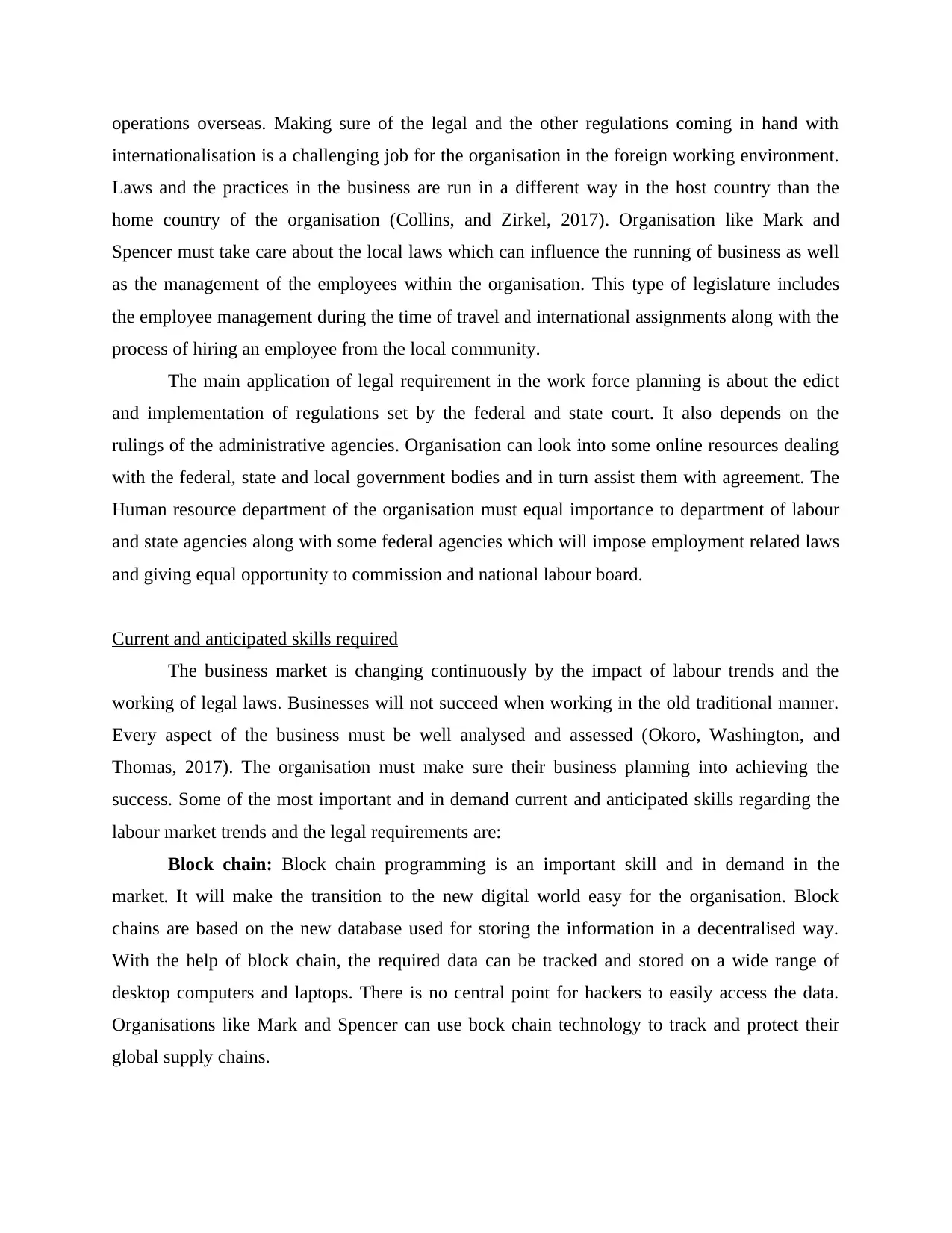
operations overseas. Making sure of the legal and the other regulations coming in hand with
internationalisation is a challenging job for the organisation in the foreign working environment.
Laws and the practices in the business are run in a different way in the host country than the
home country of the organisation (Collins, and Zirkel, 2017). Organisation like Mark and
Spencer must take care about the local laws which can influence the running of business as well
as the management of the employees within the organisation. This type of legislature includes
the employee management during the time of travel and international assignments along with the
process of hiring an employee from the local community.
The main application of legal requirement in the work force planning is about the edict
and implementation of regulations set by the federal and state court. It also depends on the
rulings of the administrative agencies. Organisation can look into some online resources dealing
with the federal, state and local government bodies and in turn assist them with agreement. The
Human resource department of the organisation must equal importance to department of labour
and state agencies along with some federal agencies which will impose employment related laws
and giving equal opportunity to commission and national labour board.
Current and anticipated skills required
The business market is changing continuously by the impact of labour trends and the
working of legal laws. Businesses will not succeed when working in the old traditional manner.
Every aspect of the business must be well analysed and assessed (Okoro, Washington, and
Thomas, 2017). The organisation must make sure their business planning into achieving the
success. Some of the most important and in demand current and anticipated skills regarding the
labour market trends and the legal requirements are:
Block chain: Block chain programming is an important skill and in demand in the
market. It will make the transition to the new digital world easy for the organisation. Block
chains are based on the new database used for storing the information in a decentralised way.
With the help of block chain, the required data can be tracked and stored on a wide range of
desktop computers and laptops. There is no central point for hackers to easily access the data.
Organisations like Mark and Spencer can use bock chain technology to track and protect their
global supply chains.
internationalisation is a challenging job for the organisation in the foreign working environment.
Laws and the practices in the business are run in a different way in the host country than the
home country of the organisation (Collins, and Zirkel, 2017). Organisation like Mark and
Spencer must take care about the local laws which can influence the running of business as well
as the management of the employees within the organisation. This type of legislature includes
the employee management during the time of travel and international assignments along with the
process of hiring an employee from the local community.
The main application of legal requirement in the work force planning is about the edict
and implementation of regulations set by the federal and state court. It also depends on the
rulings of the administrative agencies. Organisation can look into some online resources dealing
with the federal, state and local government bodies and in turn assist them with agreement. The
Human resource department of the organisation must equal importance to department of labour
and state agencies along with some federal agencies which will impose employment related laws
and giving equal opportunity to commission and national labour board.
Current and anticipated skills required
The business market is changing continuously by the impact of labour trends and the
working of legal laws. Businesses will not succeed when working in the old traditional manner.
Every aspect of the business must be well analysed and assessed (Okoro, Washington, and
Thomas, 2017). The organisation must make sure their business planning into achieving the
success. Some of the most important and in demand current and anticipated skills regarding the
labour market trends and the legal requirements are:
Block chain: Block chain programming is an important skill and in demand in the
market. It will make the transition to the new digital world easy for the organisation. Block
chains are based on the new database used for storing the information in a decentralised way.
With the help of block chain, the required data can be tracked and stored on a wide range of
desktop computers and laptops. There is no central point for hackers to easily access the data.
Organisations like Mark and Spencer can use bock chain technology to track and protect their
global supply chains.
⊘ This is a preview!⊘
Do you want full access?
Subscribe today to unlock all pages.

Trusted by 1+ million students worldwide
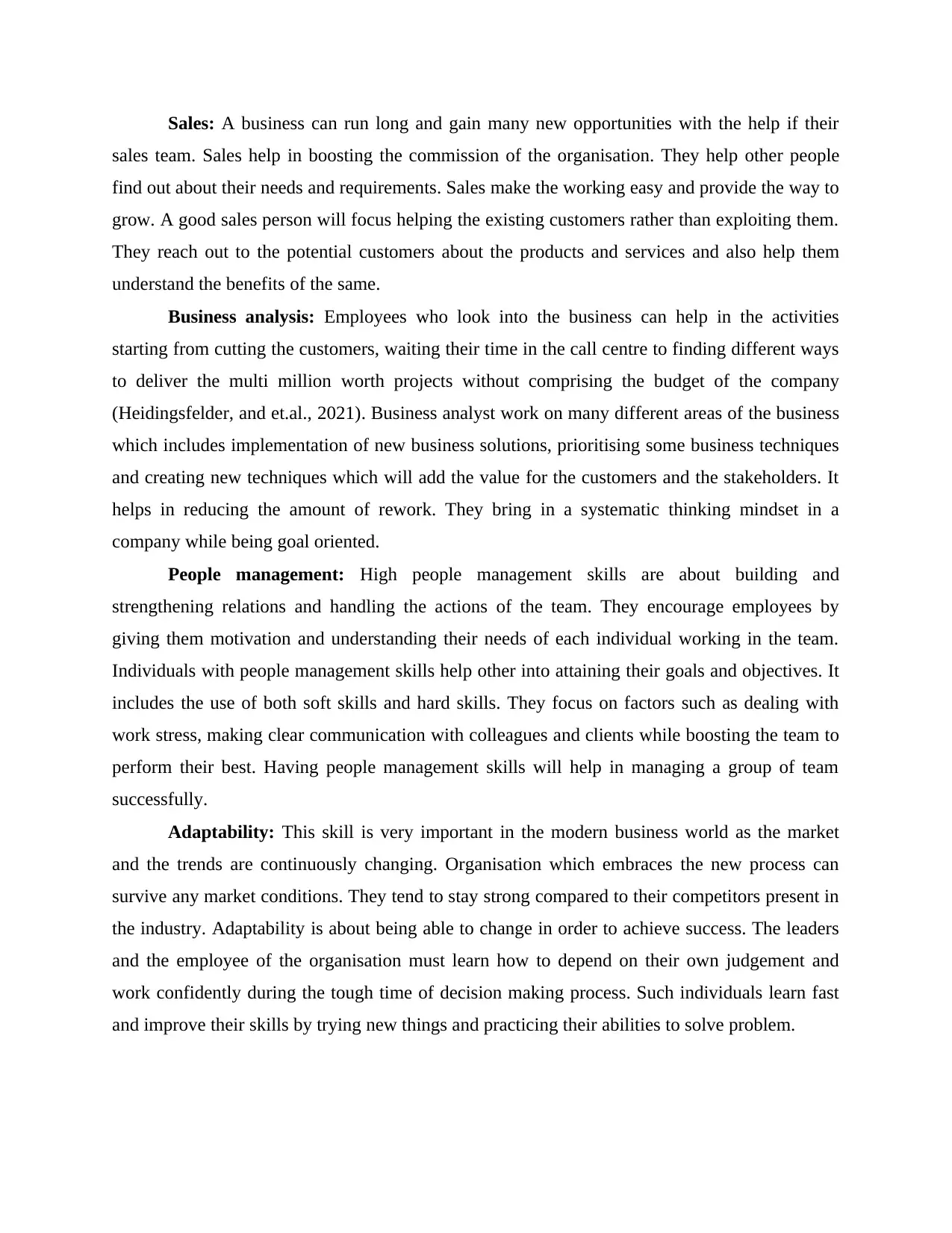
Sales: A business can run long and gain many new opportunities with the help if their
sales team. Sales help in boosting the commission of the organisation. They help other people
find out about their needs and requirements. Sales make the working easy and provide the way to
grow. A good sales person will focus helping the existing customers rather than exploiting them.
They reach out to the potential customers about the products and services and also help them
understand the benefits of the same.
Business analysis: Employees who look into the business can help in the activities
starting from cutting the customers, waiting their time in the call centre to finding different ways
to deliver the multi million worth projects without comprising the budget of the company
(Heidingsfelder, and et.al., 2021). Business analyst work on many different areas of the business
which includes implementation of new business solutions, prioritising some business techniques
and creating new techniques which will add the value for the customers and the stakeholders. It
helps in reducing the amount of rework. They bring in a systematic thinking mindset in a
company while being goal oriented.
People management: High people management skills are about building and
strengthening relations and handling the actions of the team. They encourage employees by
giving them motivation and understanding their needs of each individual working in the team.
Individuals with people management skills help other into attaining their goals and objectives. It
includes the use of both soft skills and hard skills. They focus on factors such as dealing with
work stress, making clear communication with colleagues and clients while boosting the team to
perform their best. Having people management skills will help in managing a group of team
successfully.
Adaptability: This skill is very important in the modern business world as the market
and the trends are continuously changing. Organisation which embraces the new process can
survive any market conditions. They tend to stay strong compared to their competitors present in
the industry. Adaptability is about being able to change in order to achieve success. The leaders
and the employee of the organisation must learn how to depend on their own judgement and
work confidently during the tough time of decision making process. Such individuals learn fast
and improve their skills by trying new things and practicing their abilities to solve problem.
sales team. Sales help in boosting the commission of the organisation. They help other people
find out about their needs and requirements. Sales make the working easy and provide the way to
grow. A good sales person will focus helping the existing customers rather than exploiting them.
They reach out to the potential customers about the products and services and also help them
understand the benefits of the same.
Business analysis: Employees who look into the business can help in the activities
starting from cutting the customers, waiting their time in the call centre to finding different ways
to deliver the multi million worth projects without comprising the budget of the company
(Heidingsfelder, and et.al., 2021). Business analyst work on many different areas of the business
which includes implementation of new business solutions, prioritising some business techniques
and creating new techniques which will add the value for the customers and the stakeholders. It
helps in reducing the amount of rework. They bring in a systematic thinking mindset in a
company while being goal oriented.
People management: High people management skills are about building and
strengthening relations and handling the actions of the team. They encourage employees by
giving them motivation and understanding their needs of each individual working in the team.
Individuals with people management skills help other into attaining their goals and objectives. It
includes the use of both soft skills and hard skills. They focus on factors such as dealing with
work stress, making clear communication with colleagues and clients while boosting the team to
perform their best. Having people management skills will help in managing a group of team
successfully.
Adaptability: This skill is very important in the modern business world as the market
and the trends are continuously changing. Organisation which embraces the new process can
survive any market conditions. They tend to stay strong compared to their competitors present in
the industry. Adaptability is about being able to change in order to achieve success. The leaders
and the employee of the organisation must learn how to depend on their own judgement and
work confidently during the tough time of decision making process. Such individuals learn fast
and improve their skills by trying new things and practicing their abilities to solve problem.
Paraphrase This Document
Need a fresh take? Get an instant paraphrase of this document with our AI Paraphraser
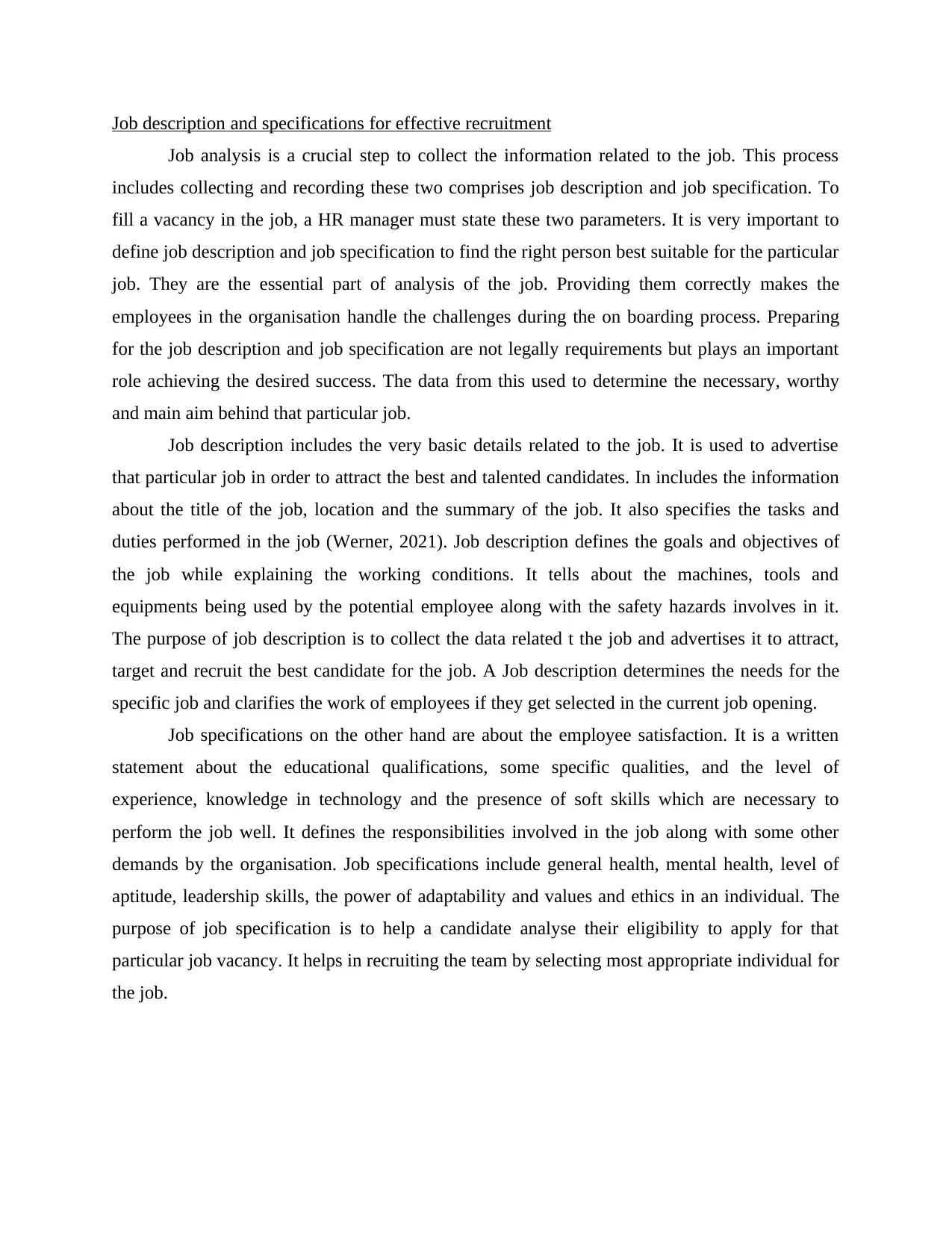
Job description and specifications for effective recruitment
Job analysis is a crucial step to collect the information related to the job. This process
includes collecting and recording these two comprises job description and job specification. To
fill a vacancy in the job, a HR manager must state these two parameters. It is very important to
define job description and job specification to find the right person best suitable for the particular
job. They are the essential part of analysis of the job. Providing them correctly makes the
employees in the organisation handle the challenges during the on boarding process. Preparing
for the job description and job specification are not legally requirements but plays an important
role achieving the desired success. The data from this used to determine the necessary, worthy
and main aim behind that particular job.
Job description includes the very basic details related to the job. It is used to advertise
that particular job in order to attract the best and talented candidates. In includes the information
about the title of the job, location and the summary of the job. It also specifies the tasks and
duties performed in the job (Werner, 2021). Job description defines the goals and objectives of
the job while explaining the working conditions. It tells about the machines, tools and
equipments being used by the potential employee along with the safety hazards involves in it.
The purpose of job description is to collect the data related t the job and advertises it to attract,
target and recruit the best candidate for the job. A Job description determines the needs for the
specific job and clarifies the work of employees if they get selected in the current job opening.
Job specifications on the other hand are about the employee satisfaction. It is a written
statement about the educational qualifications, some specific qualities, and the level of
experience, knowledge in technology and the presence of soft skills which are necessary to
perform the job well. It defines the responsibilities involved in the job along with some other
demands by the organisation. Job specifications include general health, mental health, level of
aptitude, leadership skills, the power of adaptability and values and ethics in an individual. The
purpose of job specification is to help a candidate analyse their eligibility to apply for that
particular job vacancy. It helps in recruiting the team by selecting most appropriate individual for
the job.
Job analysis is a crucial step to collect the information related to the job. This process
includes collecting and recording these two comprises job description and job specification. To
fill a vacancy in the job, a HR manager must state these two parameters. It is very important to
define job description and job specification to find the right person best suitable for the particular
job. They are the essential part of analysis of the job. Providing them correctly makes the
employees in the organisation handle the challenges during the on boarding process. Preparing
for the job description and job specification are not legally requirements but plays an important
role achieving the desired success. The data from this used to determine the necessary, worthy
and main aim behind that particular job.
Job description includes the very basic details related to the job. It is used to advertise
that particular job in order to attract the best and talented candidates. In includes the information
about the title of the job, location and the summary of the job. It also specifies the tasks and
duties performed in the job (Werner, 2021). Job description defines the goals and objectives of
the job while explaining the working conditions. It tells about the machines, tools and
equipments being used by the potential employee along with the safety hazards involves in it.
The purpose of job description is to collect the data related t the job and advertises it to attract,
target and recruit the best candidate for the job. A Job description determines the needs for the
specific job and clarifies the work of employees if they get selected in the current job opening.
Job specifications on the other hand are about the employee satisfaction. It is a written
statement about the educational qualifications, some specific qualities, and the level of
experience, knowledge in technology and the presence of soft skills which are necessary to
perform the job well. It defines the responsibilities involved in the job along with some other
demands by the organisation. Job specifications include general health, mental health, level of
aptitude, leadership skills, the power of adaptability and values and ethics in an individual. The
purpose of job specification is to help a candidate analyse their eligibility to apply for that
particular job vacancy. It helps in recruiting the team by selecting most appropriate individual for
the job.
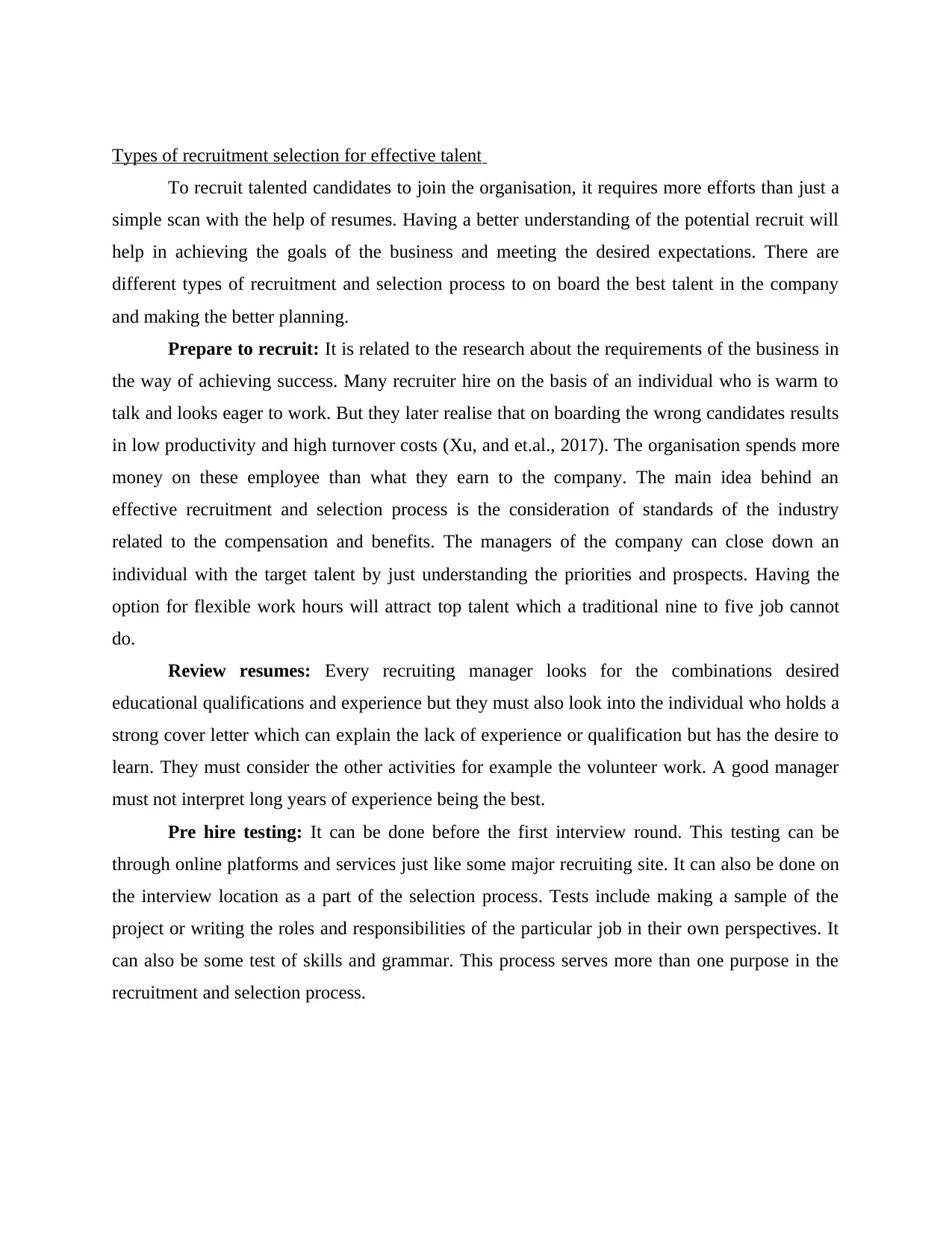
Types of recruitment selection for effective talent
To recruit talented candidates to join the organisation, it requires more efforts than just a
simple scan with the help of resumes. Having a better understanding of the potential recruit will
help in achieving the goals of the business and meeting the desired expectations. There are
different types of recruitment and selection process to on board the best talent in the company
and making the better planning.
Prepare to recruit: It is related to the research about the requirements of the business in
the way of achieving success. Many recruiter hire on the basis of an individual who is warm to
talk and looks eager to work. But they later realise that on boarding the wrong candidates results
in low productivity and high turnover costs (Xu, and et.al., 2017). The organisation spends more
money on these employee than what they earn to the company. The main idea behind an
effective recruitment and selection process is the consideration of standards of the industry
related to the compensation and benefits. The managers of the company can close down an
individual with the target talent by just understanding the priorities and prospects. Having the
option for flexible work hours will attract top talent which a traditional nine to five job cannot
do.
Review resumes: Every recruiting manager looks for the combinations desired
educational qualifications and experience but they must also look into the individual who holds a
strong cover letter which can explain the lack of experience or qualification but has the desire to
learn. They must consider the other activities for example the volunteer work. A good manager
must not interpret long years of experience being the best.
Pre hire testing: It can be done before the first interview round. This testing can be
through online platforms and services just like some major recruiting site. It can also be done on
the interview location as a part of the selection process. Tests include making a sample of the
project or writing the roles and responsibilities of the particular job in their own perspectives. It
can also be some test of skills and grammar. This process serves more than one purpose in the
recruitment and selection process.
To recruit talented candidates to join the organisation, it requires more efforts than just a
simple scan with the help of resumes. Having a better understanding of the potential recruit will
help in achieving the goals of the business and meeting the desired expectations. There are
different types of recruitment and selection process to on board the best talent in the company
and making the better planning.
Prepare to recruit: It is related to the research about the requirements of the business in
the way of achieving success. Many recruiter hire on the basis of an individual who is warm to
talk and looks eager to work. But they later realise that on boarding the wrong candidates results
in low productivity and high turnover costs (Xu, and et.al., 2017). The organisation spends more
money on these employee than what they earn to the company. The main idea behind an
effective recruitment and selection process is the consideration of standards of the industry
related to the compensation and benefits. The managers of the company can close down an
individual with the target talent by just understanding the priorities and prospects. Having the
option for flexible work hours will attract top talent which a traditional nine to five job cannot
do.
Review resumes: Every recruiting manager looks for the combinations desired
educational qualifications and experience but they must also look into the individual who holds a
strong cover letter which can explain the lack of experience or qualification but has the desire to
learn. They must consider the other activities for example the volunteer work. A good manager
must not interpret long years of experience being the best.
Pre hire testing: It can be done before the first interview round. This testing can be
through online platforms and services just like some major recruiting site. It can also be done on
the interview location as a part of the selection process. Tests include making a sample of the
project or writing the roles and responsibilities of the particular job in their own perspectives. It
can also be some test of skills and grammar. This process serves more than one purpose in the
recruitment and selection process.
⊘ This is a preview!⊘
Do you want full access?
Subscribe today to unlock all pages.

Trusted by 1+ million students worldwide
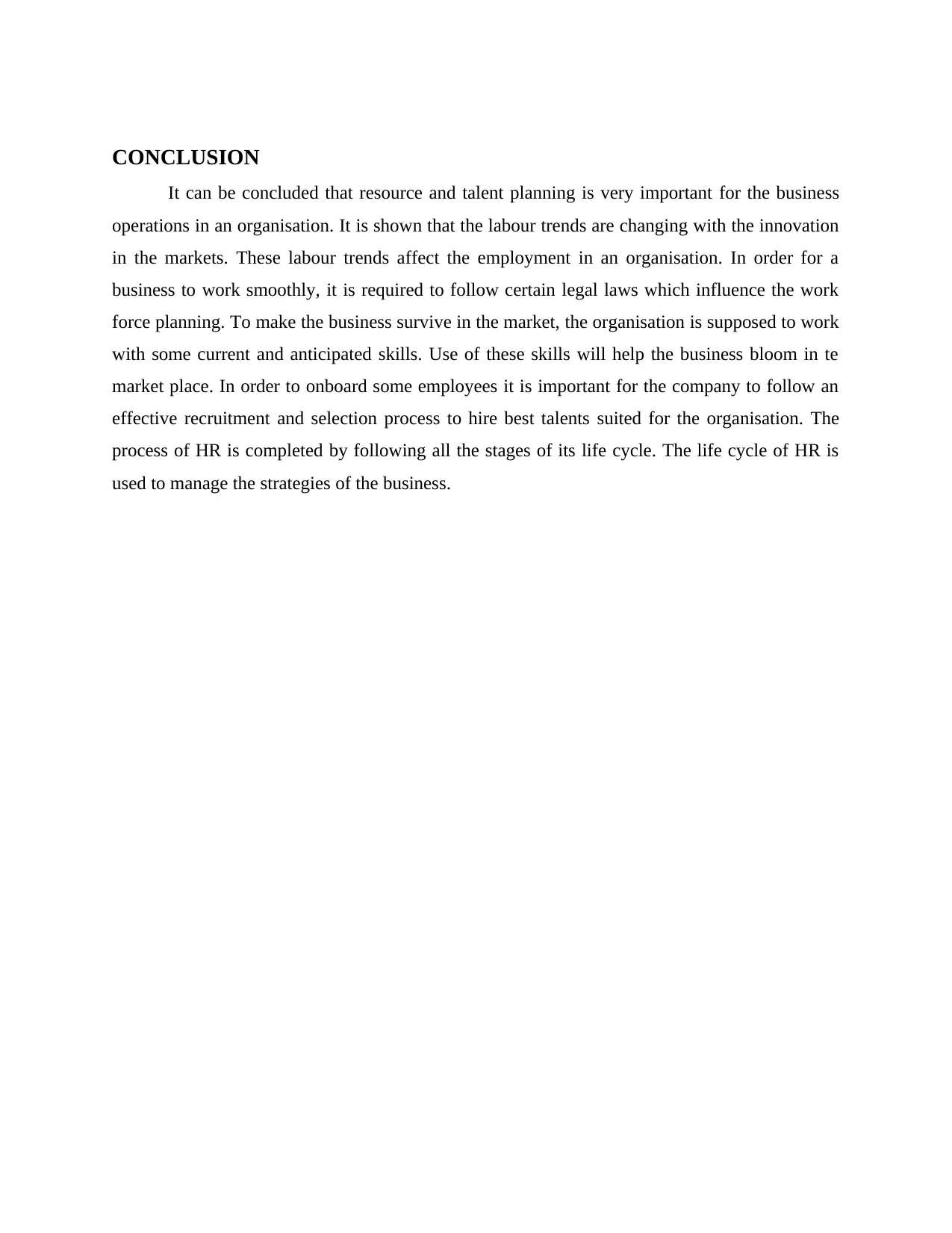
CONCLUSION
It can be concluded that resource and talent planning is very important for the business
operations in an organisation. It is shown that the labour trends are changing with the innovation
in the markets. These labour trends affect the employment in an organisation. In order for a
business to work smoothly, it is required to follow certain legal laws which influence the work
force planning. To make the business survive in the market, the organisation is supposed to work
with some current and anticipated skills. Use of these skills will help the business bloom in te
market place. In order to onboard some employees it is important for the company to follow an
effective recruitment and selection process to hire best talents suited for the organisation. The
process of HR is completed by following all the stages of its life cycle. The life cycle of HR is
used to manage the strategies of the business.
It can be concluded that resource and talent planning is very important for the business
operations in an organisation. It is shown that the labour trends are changing with the innovation
in the markets. These labour trends affect the employment in an organisation. In order for a
business to work smoothly, it is required to follow certain legal laws which influence the work
force planning. To make the business survive in the market, the organisation is supposed to work
with some current and anticipated skills. Use of these skills will help the business bloom in te
market place. In order to onboard some employees it is important for the company to follow an
effective recruitment and selection process to hire best talents suited for the organisation. The
process of HR is completed by following all the stages of its life cycle. The life cycle of HR is
used to manage the strategies of the business.
Paraphrase This Document
Need a fresh take? Get an instant paraphrase of this document with our AI Paraphraser
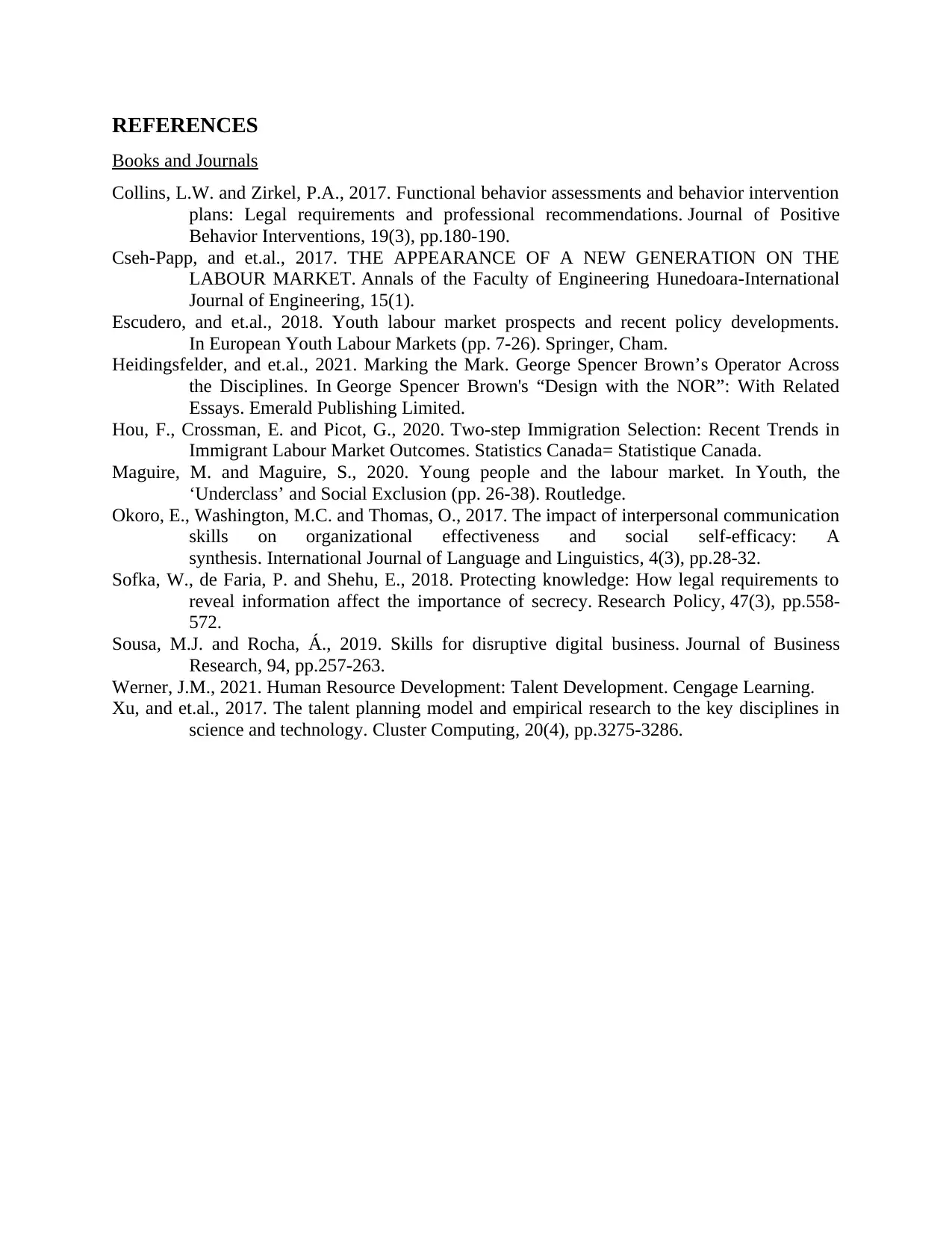
REFERENCES
Books and Journals
Collins, L.W. and Zirkel, P.A., 2017. Functional behavior assessments and behavior intervention
plans: Legal requirements and professional recommendations. Journal of Positive
Behavior Interventions, 19(3), pp.180-190.
Cseh-Papp, and et.al., 2017. THE APPEARANCE OF A NEW GENERATION ON THE
LABOUR MARKET. Annals of the Faculty of Engineering Hunedoara-International
Journal of Engineering, 15(1).
Escudero, and et.al., 2018. Youth labour market prospects and recent policy developments.
In European Youth Labour Markets (pp. 7-26). Springer, Cham.
Heidingsfelder, and et.al., 2021. Marking the Mark. George Spencer Brown’s Operator Across
the Disciplines. In George Spencer Brown's “Design with the NOR”: With Related
Essays. Emerald Publishing Limited.
Hou, F., Crossman, E. and Picot, G., 2020. Two-step Immigration Selection: Recent Trends in
Immigrant Labour Market Outcomes. Statistics Canada= Statistique Canada.
Maguire, M. and Maguire, S., 2020. Young people and the labour market. In Youth, the
‘Underclass’ and Social Exclusion (pp. 26-38). Routledge.
Okoro, E., Washington, M.C. and Thomas, O., 2017. The impact of interpersonal communication
skills on organizational effectiveness and social self-efficacy: A
synthesis. International Journal of Language and Linguistics, 4(3), pp.28-32.
Sofka, W., de Faria, P. and Shehu, E., 2018. Protecting knowledge: How legal requirements to
reveal information affect the importance of secrecy. Research Policy, 47(3), pp.558-
572.
Sousa, M.J. and Rocha, Á., 2019. Skills for disruptive digital business. Journal of Business
Research, 94, pp.257-263.
Werner, J.M., 2021. Human Resource Development: Talent Development. Cengage Learning.
Xu, and et.al., 2017. The talent planning model and empirical research to the key disciplines in
science and technology. Cluster Computing, 20(4), pp.3275-3286.
Books and Journals
Collins, L.W. and Zirkel, P.A., 2017. Functional behavior assessments and behavior intervention
plans: Legal requirements and professional recommendations. Journal of Positive
Behavior Interventions, 19(3), pp.180-190.
Cseh-Papp, and et.al., 2017. THE APPEARANCE OF A NEW GENERATION ON THE
LABOUR MARKET. Annals of the Faculty of Engineering Hunedoara-International
Journal of Engineering, 15(1).
Escudero, and et.al., 2018. Youth labour market prospects and recent policy developments.
In European Youth Labour Markets (pp. 7-26). Springer, Cham.
Heidingsfelder, and et.al., 2021. Marking the Mark. George Spencer Brown’s Operator Across
the Disciplines. In George Spencer Brown's “Design with the NOR”: With Related
Essays. Emerald Publishing Limited.
Hou, F., Crossman, E. and Picot, G., 2020. Two-step Immigration Selection: Recent Trends in
Immigrant Labour Market Outcomes. Statistics Canada= Statistique Canada.
Maguire, M. and Maguire, S., 2020. Young people and the labour market. In Youth, the
‘Underclass’ and Social Exclusion (pp. 26-38). Routledge.
Okoro, E., Washington, M.C. and Thomas, O., 2017. The impact of interpersonal communication
skills on organizational effectiveness and social self-efficacy: A
synthesis. International Journal of Language and Linguistics, 4(3), pp.28-32.
Sofka, W., de Faria, P. and Shehu, E., 2018. Protecting knowledge: How legal requirements to
reveal information affect the importance of secrecy. Research Policy, 47(3), pp.558-
572.
Sousa, M.J. and Rocha, Á., 2019. Skills for disruptive digital business. Journal of Business
Research, 94, pp.257-263.
Werner, J.M., 2021. Human Resource Development: Talent Development. Cengage Learning.
Xu, and et.al., 2017. The talent planning model and empirical research to the key disciplines in
science and technology. Cluster Computing, 20(4), pp.3275-3286.

⊘ This is a preview!⊘
Do you want full access?
Subscribe today to unlock all pages.

Trusted by 1+ million students worldwide
1 out of 12
Related Documents
Your All-in-One AI-Powered Toolkit for Academic Success.
+13062052269
info@desklib.com
Available 24*7 on WhatsApp / Email
![[object Object]](/_next/static/media/star-bottom.7253800d.svg)
Unlock your academic potential
Copyright © 2020–2025 A2Z Services. All Rights Reserved. Developed and managed by ZUCOL.





